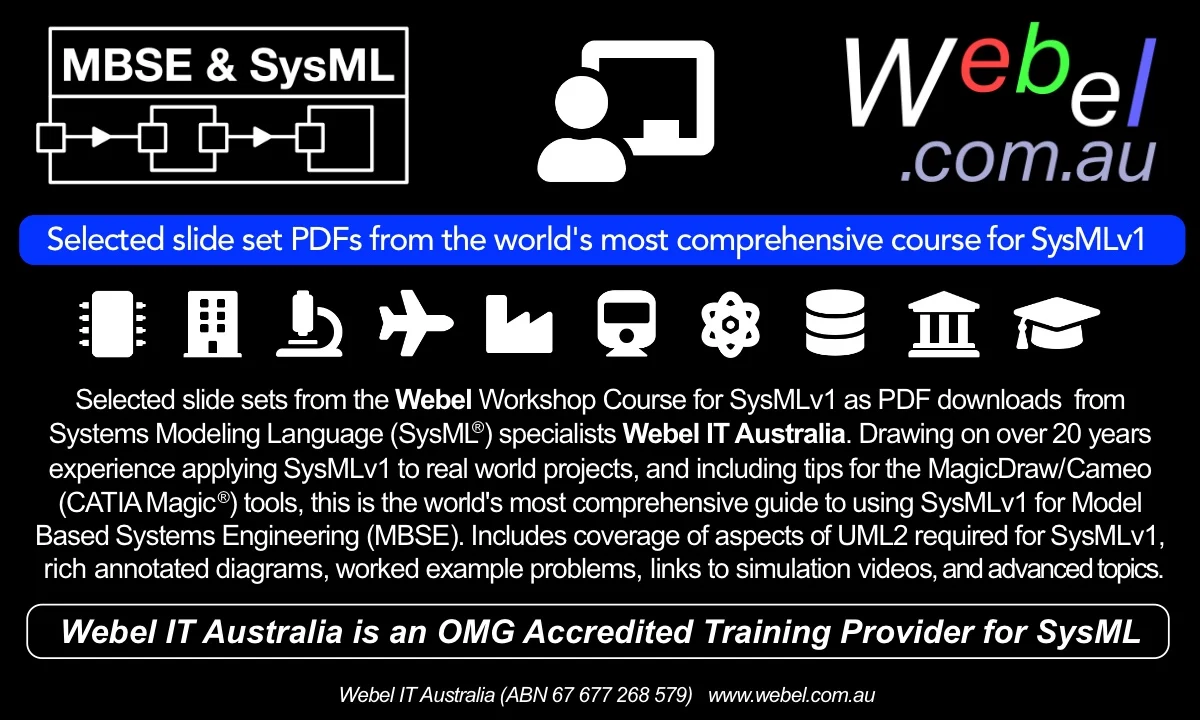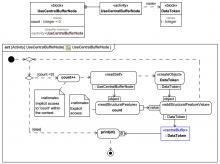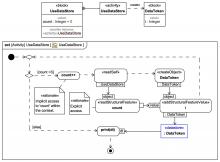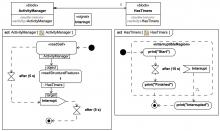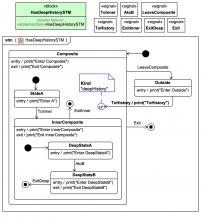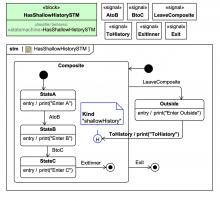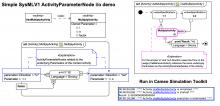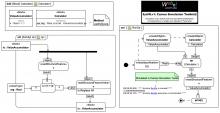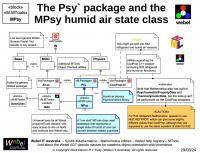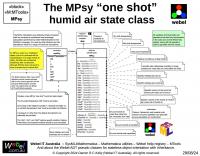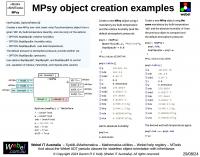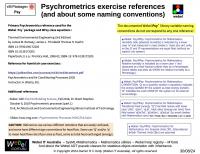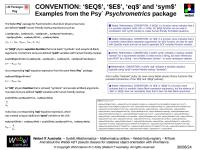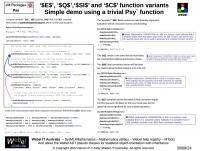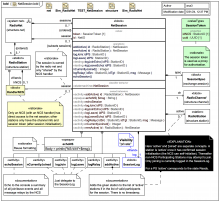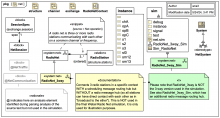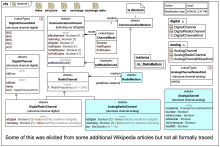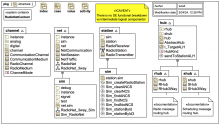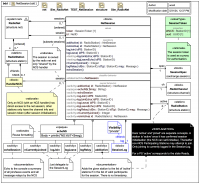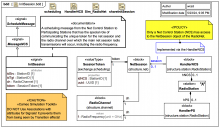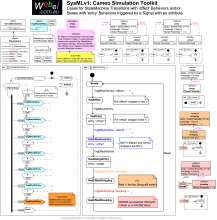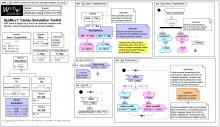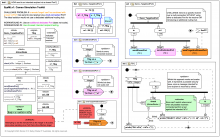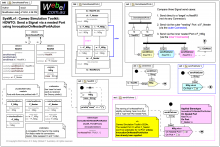- Home
- About
- SysML/MBSE Training
- SysML Q&A
- Services
- Model-Based Systems Engineering with SysML
- SysML/MBSE Training & e-Learning
- SysML/MBSE Educational Consultancy web sessions
- Model-Based Software Engineering
- Python and REST web service APIs and OpenAPI
- Docker application deployment for VPS and Traefik
- Data modelling: XML, JSON, databases
- Wolfram Mathematica: Data analysis & visualisation
- Spreadsheet data extraction and migration
- Physics simulations, technical animations, 3D modelling
- Technical Media: Video, Audio, Graphics
- Drupal CMS web sites & PHP
- Keywords
- Contact
MBSE
The secure slide set PDFs bundle download purchase link is now here!
Dr Darren's open letter to the SysML and MBSE communities about SysMLv2 content for the new Webel Q&A online self-testing system for SysML
Thanks to all my SysML and MBSE colleagues on LinkedIn groups and elsewhere for your positive feedback about the concept behind the new Webel Q&A online self-testing system for SysML.
SysMLv1: Cameo Simulation Toolkit: StateMachine with deferred Signal event Trigger [with mini video]
About Webel's Live Online Educational Consultancy Service for SysML/MBSE, including help preparing for the OCSMP exams, UML, OCL, and more
We are offering a HUGE 50% DISCOUNT off all Live Online SysMLv1/MBSE web sessions for individuals held before 30th November 2025 (pre-pay only). Offered only subject to availability.
NEWS: Webel IT Australia is now an OMG Accredited Trainer for Systems Modeling Language (SysML)
2024-05-07 Webel IT Australia is now an OMG Accredited Trainer for Systems Modeling Language (SysML) and selected OMG-Certified Systems Modeling Language™ (SysML®) Professional (OCSMP) certification exams!
SysMLv1: Cameo Simulation Toolkit: Cases for Transitions triggered by Signals sent direct to a remote target vs via Ports [with mini video]
This content has been marked as discussing an ADVANCED topic!
SysMLv1: Cameo Simulation Toolkit: HOWTO handle sending and receiving families of related Signal types with reuse of send/receive and processing logic [with mini video]
This content has been marked as discussing an ADVANCED topic!
[EXTERNAL LINKS] Cameo Simulation Toolkit (aka Magic Model Analyst) videos and guides
A collection of EXTERNAL links (scroll down) to videos, slides, and other guides on Magic Model Analyst® (Cameo Simulation Toolkit®). These links are included here as additional resources and do not replace the Webel IT Australia online SysML/MBSE educational resources or the Webel training course materials:
Dr Darren says: Don't be scared to put yourself out there with your SysML Diagrams in public and in your work with colleagues
Dr Darren explains:
Many years ago, on a very old version of the Webel site, I had up a quick attempt at mapping out the families of physics particles in SysML. Although I have a PhD in physics (astrophysics), and had even worked at the DESY particle accelerator institute (on data analysis, and modelling and operating the machines, not particle physics), I am not an expert in particle physics.
Dr Darren's Open Letter to the LinkedIn groups for MBSE, SysML, MagicDraw, and INCOSE concerning comment and message replies
Dr Darren says:
Welcome, if you have been referred here it may be in response to my sending a link to this page in reply to your comments or questions on LinkedIn.
To all LinkedIn groups involving MBSE, Systems Engineering, SysML, and the MagicDraw/Cameo tools,
I am no longer offering comments or answering questions in comment threads (or in reply to LinkedIn messages) on any LinkedIn group involving MBSE, SysML, or SysML tools.
Q: What types of simulation, execution, and calculation are available for SysML with MagicDraw/Cameo?
There are a number of ways of simulating and executing various aspects of Systems Modeling Language v1 (SysML®), and they are not just novelties! They also really help your models become more robust, logical, and organised.
There is "internal" tool simulation of Activities and StateMachines based on fUML (or variations of it).
Topic outline for Full SysML Workshop (5-Day) course version: 'Model-Based Systems Engineering with the OMG's Systems Modeling Language v1 (SysML®) and the MagicDraw/Cameo (CATIA Magic™) tools for SysML'
Webel IT Australia is an OMG-Accredited Training Provider for SysML!
We are offering a HUGE 50% DISCOUNT off all SysMLv1/MBSE group course bookings fully pre-paid by 30th Nov 2025!
Topic outline for Mini SysML Workshop (4-Day) and SysMLv1 Language Intro (4-Day or 3-Day) course versions: 'Model-Based Systems Engineering with the OMG's Systems Modeling Language v1 (SysML®) and the MagicDraw/Cameo (CATIA Magic™) tools for SysML'
Webel IT Australia is an OMG-Accredited Training Provider for SysML!
We are offering a HUGE 50% DISCOUNT off all SysMLv1/MBSE group course bookings fully pre-paid by 30th Nov 2025!
Webel's Best Practice policy notes for MBSE with SysML1.x (and UML) and the MagicDraw/Cameo tools
The Webel Best Practice items for SysML (and for supporting UML) - tuned for the MagicDraw/Cameo tools - represent the world's most comprehensive guide to robust, fluent, enjoyable, consistent modelling for Model-Based Systems Engineering (MBSE), developed over two decades, and proven to work on extremely demanding real-world projects!
Service: Model-Based Systems Engineering with SysML (consultancy)
Looking for
IT Training in Systems Modeling Language v1 (SysML®)?
Screencast: The LogicalWrapper: A proposal for a new element for UML and SysMLv1.x and SysMLv2
Video style
© Copyright 2019 Darren R C Kelly (Webel IT Australia). All rights reserved.
This 4K narrated screencast video accompanies the white paper of the same name by Darren Kelly of Webel IT Australia available here.
Course: Model-Based Systems Engineering with OMG Systems Modeling Language® (v1) and the MagicDraw/Cameo (CATIA Magic™) tools for SysML
The world's most comprehensive hands-on Systems Modeling Language v1 (SysML®) course presented by one of the world's top SysML® modelling experts.
Webel IT Australia is an OMG-Accredited Training Provider for SysML!
Magic Cyber-Systems Engineer® (Cameo Systems Modeler®) zone
For tips and tutorials for the Magic Model Analyst® (Cameo Simulation Toolkit®) plugin visit:
MagicDraw UML (Magic Software Architect) zone
Dr Darren of Webel IT Australia is a long-term MagicDraw® user, and previously worked for the developers No Magic Inc as a consultant and trainer (Expert Advisor for Science, Engineering, and Education).
This zone is primarily about applications of MagicDraw® to software engineering wi
The Webel Parsing Analysis recipe for SysML
Please email or phone Webel IT Australia on +61 405 029 008 to enquire about our SysML Domain Modelling and Requirements Engineering services!
Webel IT Australia is the home of the Webel Parsing Analysis recipe for SysML, a very powerful technique for translating text from authoritativeSysML zone
You have arrived at the world's most comprehensive online guide to applying Model-Based Systems Engineering with SysML® to real-world systems. For full access to our SysML Education resources & materials attend our workshop course!


